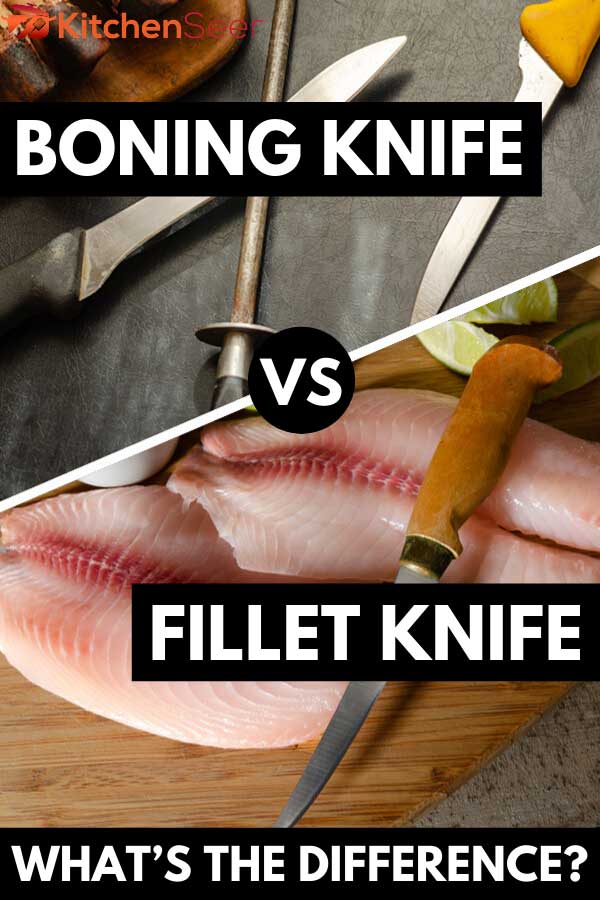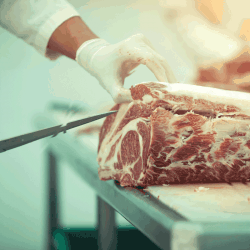 “To fillet” literally means, “to remove the bones from meat.” So, what’s the deal with boning knives? If you’re confused about the differences between boning and fillet knives, don’t worry; we’ve done some research so you could “sharpen” your culinary knife skills.
“To fillet” literally means, “to remove the bones from meat.” So, what’s the deal with boning knives? If you’re confused about the differences between boning and fillet knives, don’t worry; we’ve done some research so you could “sharpen” your culinary knife skills.
Boning knives are used to separate meat from bones and to get rid of excess fat and cartilage. Although boning knives have some give, they are stiffer than fillet knives, making them better choices for tough meats and poultry. The thinner fillet knives, however, are often used for removing skin from meat and deboning fish.
If you’re interested in these two knife models, then be sure to read through the rest of this post.
Boning Knife Vs. Fillet Knife: What’s The Difference?
You might get away with using these knives interchangeably, but boning and fillet knives have distinct features worth pointing out. In this first section, we’ll clarify the common uses for boning and fillet knives.
What Is A Boning Knife Used For?
As suggested in its name, boning knives should be used for removing meat from bones. This thin blade’s sharpness and moderate flexibility make it particularly useful for cutting meat in tricky areas like joints. Boning knives are indispensable for those interested in cutting chicken or turkey.
Besides separating meat from bones, many people use boning knives to trim excess fat and cartilage. It’s common to use boning knives to get rid of unwanted fat on popular cuts like port tenderloin, rack of lamb, and beef tenderloin.
While boning knife blades are thin, they usually aren’t as thin or bendable as the ones you’ll find on fillet knives. This increased rigidity makes boning knives fantastic for cutting tougher meats like pork and steak.
If you’re planning on preparing some beef with your boning knife, then you might be interested in our previous post on cooking steak with non-stick skillets.
What Is A Fillet Knife Used For?
Technically, fillet knives should only be used to separate the skin from the meat. In the real world, however, it’s common to use fillet knives for deboning—especially with fish. It’s not a bad idea to associate “fillet” with “fish” if it helps you distinguish boning and fillet knives.
The reason fishmongers favor fillet knives is because these blades are flexible. Compared with boning knives, fillet knives are also lighter, making them easy to use on delicate fish meat.
Because fillet knives have such thin blades, they don’t perform as well as boning knives when cutting steak, poultry, or pork. You’ll quickly wear out your fillet knife’s blade on these foods. Not only that, but fillet knives also have a ton of give, which means it’s far easier for your hand to slip when you’re working with tougher meats.
Fillet Versus Filet: Is There A Difference?
Did you ever notice that fish are often sold in “fillets,” but the second “l” mysteriously disappears when you buy a “filet mignon?” New chefs understandably wonder whether there’s any significant difference between knives labeled “fillet” and “filet.”
Simply put: there’s no difference between “fillet” and “filet.” Both words are alternative spellings from the original French. In North America, however, “fillet” is generally reserved for fish while “filet” has become associated with fancy-pants steak cuts.
Here’s a fact to impress your friends: “fillet” originally referred to a fine thread in France in the Middle Ages. Around the 14th century, this word became associated with cuts of meat because butchers would tie their products with thin strings.
Choosing The Best Blade: Tips When Shopping For Fillet & Boning Knives
In this next section, we’ll examine a few common questions consumers have when searching for the best fillet and boning knives.
How Long Should A Boning Knife Be?
The average length for a boning knife is between 5–7 inches, but it’s not unheard of for blades to reach 9 inches. Of course, the best length for you depends on your hand size and the cuts you’re working with. On average, pro chefs recommend boning knives with a 6-inch blade.
Although the length could vary, boning knives should have a bolster between the blade and the handle for safety. All boning knives should also have a curve at the top of the blade and a straightedge back.
Today, Mercer Culinary’s Millennia is one of the best-reviewed boning knives on the market.
You can easily purchase this product by following this Amazon link.
How Flexible Should A Fillet Knife Be?
Flexibility is the defining feature of a fillet knife, so this blade should bend when you press it against a cutting board. Remember, this knife is best suited for cutting off skin and bones in fish, so you need all maneuverability you can get.
If you frequently cook fish in your kitchen, you might be interested in this previous KitchenSeer post on deep-frying fish.
What Is The Best Fillet Knife For Fish?
Currently, KastKing puts out one of the most popular fillet knives specifically for cutting fish. These knives are made with high-grade German steel and have a slip-resistant polymer handle. You could choose from a variety of sizes ranging from 5 to 9 inches, depending on what fish you frequently fillet.
You can easily find the KastKing fillet knives for sale online.
To purchase this product, please check out this Amazon link.
Debone With Dignity: Use Boning & Fillet Knives With Their Proper Meats
True, fillet and boning knives have a lot of similarities, but they aren’t the same. Be sure to use the slightly rigid design of the boning knife to your advantage when preparing tougher meats and poultry. For fabulous fish, however, it’s best to break out your ultra-flexible fillet knife.






![Portrait of a dying Black Drum fish caught with a hook where the line, lead and some blood can be seen. - Can You Eat A Black Drum Fish? [Yes! Here's How To Prepare It!]](https://kitchenseer.com/wp-content/uploads/2022/10/Portrait-of-a-dying-Black-Drum-fish-caught-with-a-hook-where-the-line-lead-and-some-blood-can-be-seen.-Can-You-Eat-A-Black-Drum-Fish-Ye-250x250.jpg)

